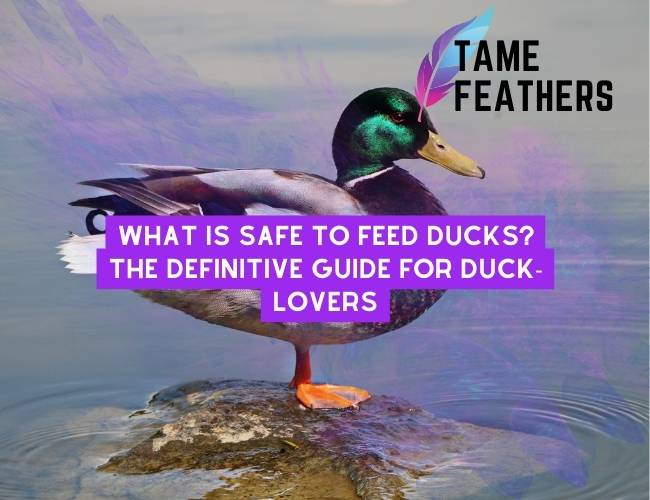Feeding ducks can be a fun and fulfilling pastime, offering delight for both you and the ducks. Before you head out to the local pond or park with a bag full of bread, however, it’s important to be aware that not all human food is safe for our feathered friends.
In fact, feeding ducks the wrong type of food can have harmful consequences for their health and the environment.
When it comes to providing nourishment for ducks, it’s essential to know what is safe and beneficial for their well-being. By understanding the nutritional needs of ducks and learning about the best food options for them, you can ensure that your activities are both enjoyable and ecologically responsible.
So let’s dive right in and explore the world of duck nutrition, so that you can make informed choices and create lasting memories with these delightful aquatic creatures – all while helping them thrive and flourish.
Understanding Ducks’ Dietary Needs
As an enthusiastic duck caretaker or nature lover, it’s essential that you feed these feathered friends a well-balanced and nutritional diet. Ducks, being omnivorous, consume both plant-based and animal-based foods. However, their dietary requirements may vary depending on their age, habitat, and species. In this section, let’s delve into the crucial aspects of ducks’ dietary needs.
Ducklings, during their initial weeks of life, rely heavily on protein-rich food sources. You can provide them with a starter diet specifically designed for waterfowl or game birds, containing about 20-22% protein. Gradually, after the first two months, their protein requirements decrease. You can then switch to feeding them a grower diet containing approximately 16-18% protein content.
For adult ducks, a well-rounded diet should include:
- Pelleted waterfowl or poultry feed: Ensure it is specially formulated for ducks with about 14-16% protein content.
- Grains: Whole grains like wheat, barley, oats, or cracked corn can make up a small portion of their diet.
- Leafy Greens: Incorporate lettuce, spinach, kale, or Swiss chard to provide required vitamins and minerals.
- Vegetables and fruits: Ducks love chopped vegetables like carrots, peas, and cucumbers, as well as small bites of fruits such as melons, grapes, or berries.
It’s crucial to avoid feeding ducks certain foods that can lead to health issues:
- Bread, pastries, or baked goods: These offer little nutritional value and can lead to obesity.
- Salty, sugary, or processed foods: These can disrupt ducks’ metabolism and negatively impact their health.
- Foods containing pesticides or other chemicals: These substances can be toxic to ducks.
Lastly, ducks need a steady supply of clean, fresh water to drink and moisten their food. Water is essential not only for hydration but also helps them properly digest and absorb nutrients from their meals. Be vigilant to replace their drinking water multiple times daily.
By considering these pivotal aspects of ducks’ dietary needs, you’ll be better equipped to ensure the health and happiness of these charming creatures. Give them a diet that’s both nutritious and enjoyable, and these fine-feathered friends will undoubtedly thrive under your care.
Safe Foods for Feeding Ducks
Feeding ducks can be an enjoyable activity and a great way to interact with wildlife. However, it’s important to know what types of foods are safe for ducks to consume. Providing the proper diet will ensure the health and well-being of these birds, as well as minimize any adverse effects on their natural habitat. In this section, we’ll outline several safe foods that you can offer to ducks.
When feeding ducks, aim to provide a balanced diet containing a variety of nutrients. Some excellent food choices include:
- Grains: Ducks appreciate a mix of grains such as oats, wheat, barley, and rice. These provide essential carbohydrates and nutrients for their overall health. Make sure to offer uncooked grains as cooked or processed grains can be too soft or contain harmful additives.
- Leafy Greens: Ducks enjoy a variety of leafy greens, like lettuce, kale, spinach, and cabbage. These vegetables offer a good amount of vitamins and minerals, contributing to a healthy diet.
- Vegetables: Other vegetables, such as peas, corn, and chopped carrots, can also be a nutritious addition to a duck’s diet. Ensure that the vegetables are fresh and cut into small, easily digestible pieces.
- Aquatic Plants: In a natural habitat, ducks feed on various water plants like duckweed, pondweed, and algae. If you have access to such plants, they can be a healthy option for ducks.
To provide a clearer understanding of these safe food choices, below is a table outlining some of the key nutrients each food group offers:
| Food Group | Key Nutrients |
|---|---|
| Grains | Carbohydrates, Fiber, Protein, Vitamins (B, E), Minerals (Iron) |
| Leafy Greens | Vitamins (A, C, K), Minerals (Calcium, Potassium, Magnesium) |
| Vegetables | Vitamins (A, C, E), Minerals (Potassium, Iron, Zinc), Fiber |
| Aquatic Plants | Vitamins (A, C), Minerals (Calcium, Phosphorus), Fiber |
In addition to these safe foods, there are commercially available duck feeds or waterfowl pellets, which are specifically formulated to meet their nutritional needs. You can find these at pet stores or farm feed suppliers.
There are a few key things to remember when feeding ducks:
- Offer food in small, scattered amounts, which encourages natural foraging behavior.
- Avoid feeding ducks in large groups to prevent overcrowding and stress.
- Refrain from tossing food directly into the water, as it can contribute to water pollution and attract unwanted pests.
With these guidelines in mind, you can ensure that your duck feeding experience is both enjoyable and beneficial to the ducks themselves.
What Not to Feed Ducks
When it comes to feeding ducks, it’s important to understand that not all human food is safe for them. Feeding the wrong food can lead to serious health issues and even death. In this section, we will discuss the types of foods you should avoid giving to ducks and the reasons why they are harmful.
First and foremost, avoid feeding ducks any type of bread. White, whole grain, or even gluten-free bread can cause various problems for ducks, including malnutrition and a condition called “angel wing,” which can render them unable to fly. The reason is that bread lacks the essential nutrients ducks require to stay healthy, and it can also lead to overpopulation and pollution around ponds and lakes.
Apart from bread, here’s a list of other common foods that you should avoid giving to ducks:
- Crackers and chips: These processed foods share the same issues as bread, lacking essential nutrients and potentially contributing to malnutrition.
- Popcorn: Even unsalted and unbuttered popcorn can cause digestive problems in ducks, leading to discomfort and potential health issues.
- Candy and sweets: High sugar content in candies and sweets can cause problems with the duck’s digestive system.
- Chocolate: Chocolate is toxic to many animals, ducks included, and should never be fed to them.
- Onions and garlic: These foods can be toxic to ducks, causing digestive problems and potentially damaging their red blood cells.
It’s worth noting that feeding ducks can also lead to larger problems beyond individual health issues. When ducks become reliant on human-provided food, they may lose their natural foraging skills and migrate less often, affecting the ecosystem and the balance of their natural habitats. Additionally, leftover food can attract pests and contribute to water pollution.
To keep ducks healthy and maintain the environment around them, it’s crucial to provide them with the proper food that meets their nutritional needs. Some safe alternatives to human food include:
- Cracked corn
- Duck pellets
- Leafy greens (torn into small pieces)
- Frozen peas or corn (defrosted)
- Oats or barley
Consider these options the next time you plan on feeding ducks, and make sure to avoid the foods mentioned in this section. By doing so, you’ll contribute to the well-being of these wonderful creatures and the environment they live in.
Proper Feeding Techniques
In order to keep ducks healthy and maintain a clean environment, it’s crucial to use proper feeding techniques. In this section, we will discuss a few essential feeding guidelines to ensure you’re providing the best nutrition for ducks while minimizing the potential for pollution and other hazards.
Choosing the Right Foods
Before heading out to feed ducks, make sure you have suitable food options. Opt for foods rich in nutrients that benefit ducks’ health. Some nutritious foods for ducks include:
- Grains: corn, wheat, barley or rice
- Vegetables: chopped lettuce, peas, or cucumber
- Ducks pellets or other specialized waterfowl feeds
Avoid feeding ducks bread, chips, and other processed foods as they lack nutritional value and can lead to health issues.
Quantity Control
It’s essential to keep track of the amount of food you offer ducks. Overfeeding can endanger ducks by encouraging their reliance on humans for sustenance, which might cause malnourishment or overpopulation. To prevent this, follow these general guidelines:
- Adult ducks: 1/2 cup (120 ml) of food daily for every 10 ducks
- Ducklings: 1/4 cup (60 ml) of food daily per duckling
Keep in mind that these quantities can vary based on the size and breed of the ducks. When in doubt, consult a specialist or observe the recommended portion sizes on commercial duck feed packages.
Safe Feeding Environment
Creating a safe feeding environment for ducks is equally important as giving them the right food. Below are some tips for promoting a safe disbursement of food:
- Avoid tossing food directly into the water, as it may contribute to water pollution and cause harmful algae blooms. Instead, place the food on the ground or in shallow water so the ducks can easily access it.
- Choose a designated spot for feeding ducks to prevent the spread of waste and leftovers. This helps maintain cleanliness and reduces the likelihood of attracting pests or predators to the area.
- Scatter the food over a broad area to encourage the ducks to forage naturally and avoid crowding or competition among them.
Following these proper feeding techniques can help you effectively nourish local duck populations without endangering their health or the environment. Remember, giving ducks appropriate food in suitable spots and in proper amounts is the key to fostering a healthy and pleasant duck-feeding experience.
Conclusion
In conclusion, feeding ducks can be a fun, rewarding, and educational experience for all ages. It’s essential to consider the health and well-being of these waterfowl when providing them with food. To recap, here are some key takeaways on what is safe to feed ducks:
- Always opt for duck-specific food, such as pellets, if available.
- Provide an appropriate balanced diet with a mix of:
- Leafy greens like lettuce or spinach
- Vegetables, such as peas, corn, or chopped zucchini
- Grains like oats, barley, and rice
- Protein sources including mealworms, earthworms, or chopped boiled eggs
- Avoid feeding ducks bread, crackers, chips, or other processed foods.
- Never overfeed ducks, as it can cause overcrowding and pollution, which negatively impact their wellbeing.
Feeding ducks the right foods contributes to their growth, development, and overall health. It also helps maintain a clean, pollutant-free environment for both them and other wildlife species.
Remember that wildlife typically has access to their natural food source. Therefore, feeding ducks should be sporadic and occasional, ensuring they continue foraging for their nutrition. By adhering to these guidelines and offering safe, nutritional food options, you can participate in responsible duck feeding and contribute to the conservation and well-being of these beautiful creatures.
So, next time you head to the park or visit a local pond, be sure to pack some wholesome, duck-friendly treats. This simple act of kindness will not only bring joy to you and the ducks, but it will also help support a thriving ecosystem for all to enjoy.



